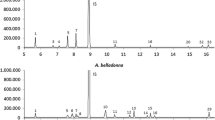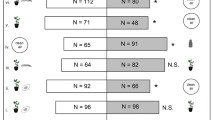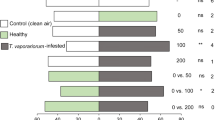Abstract
The tomato leafminer, Tuta absoluta (Lepidoptera: Gelechiidae), is considered to be a major pest that damages tomato (Solanum lycopersicum L; Solanaceae) crops in South American, European, and Mediterranean countries. This insect species is polyphagous (i.e., feeds on many types of food); hence, it could also develop on other cultivated host plants, principally solanaceous plants, such as potato (S. tuberosum L.; Solanaceae) and eggplant (S. melongena L.; Solanaceae). Therefore, we tested the hypothesis that host plant choice by adult T. absoluta is influenced by plant volatile organic compounds and larval host plant experience. One tomato cultivar (cv.) ‘Moneymaker’ and three potato cv. ‘Charlotte’ ‘Bintje,’ and ‘Nicola’ were tested. Using a flying tunnel, we observed that females reared on tomato preferred flying toward tomato and, to a lesser extent, potato cv. ‘Charlotte.’ These preferences might be explained by the high release of terpenes by these two plants. When conducting oviposition choice assays, we found no preference between tomato and potato in the number of eggs laid by females that had been previously reared on either host plant. This study indicates that the host finding behavior of T. absoluta is mediated by solanaceous volatiles, while oviposition behavior appears to depend on additional stimuli. These results provide baseline information for use in the development of new control strategies against T. absoluta using semiochemicals and plant breeding.



Similar content being viewed by others
References
Adams RP (2007) Identification of essential oil components by gas chromatography/mass spectrometry. Illinois, USA, 804 p
Anderson P, Sadek MM, Larsson M, Hansson BS, Thöming G (2013) Larval host plant experience modulates both mate finding and oviposition choice in a moth. Anim Behav 85(6):1169–1175. doi:10.1016/j.anbehav.2013.03.002
Awmack CS, Leather SR (2002) Host plant quality and fecundity in herbivorous insects. Annu Rev Entomol 47(1):817–844
Azuma H, Thien LB, Toyota M, Asakawa Y, Kawano S (1997) Distribution and differential expression of (E)-4,8-dimethyl-1,3,7-nonatriene in leaf and floral volatiles of Magnolia and Liriodendron taxa. J Chem Ecol 23(11):2467–2478
Bernays EA (2001) Neural limitations in phytophagous insects: Implications for diet breadth and evolution of host affiliation. Annu Rev Entomol 46:703–727
Beyaert I, Hilker M (2014) Plant odour plumes as mediators of plant–insect interactions. Biol Rev 89(1):68–81
Bleeker PM, Diergaarde PJ, Ament K, Guerra J, Weidner M, Schütz S, de Both MTJ, Haring MA, Schuurink RC (2009) The role of specific tomato volatiles in tomato-whitefly interaction. Plant Physiol 151(2):925–935
Bolter CJ, Dicke M, Van Loon JJA, Visser JH, Posthumus MA (1997) Attraction of Colorado potato beetle to herbivore-damaged plants during herbivory and after its termination. J Chem Ecol 23(4):1003–1023
Caparros Megido R, Haubruge E, Verheggen FJ (2012) First evidence of deuterotokous parthenogenesis in the tomato leafminer, Tuta absoluta (Meyrick) (Lep., Gelechiidae). J Pest Sci 85(4):409–412
Caparros Megido R, Brostaux Y, Haubruge E, Verheggen FJ (2013) Propensity of the Tomato Leafminer, Tuta absoluta (Lepidoptera: Gelechiidae), to develop on four potato plant varieties. Am J Potato Res 90(3):255–260
Costa JF, Cosio W, Cardenas M, Yábar E, Gianoli E (2009) Preference of quinoa moth: Eurysacca melanocampta Meyrick (Lepidoptera: Gelechiidae) for two varieties of quinoa (Chenopodium quinoa Willd.) in olfactometry assays. Chil J Agric Res 69(1):71–78
De Moraes CM, Mescher MC, Tumlinson JH (2001) Caterpillar-induced nocturnal plant volatiles repel conspecific females. Nature 410(6828):577–579
Desneux N, Wajnberg E, Wyckhuys KAG, Burgio G, Arpaia S, Narváez-Vasquez CA, González-Cabrera J, Ruescas DC, Tabone E, Frandon J, Pizzol J, Poncet C, Cabello T, Urbaneja A (2010) Biological invasion of European tomato crops by Tuta absoluta: ecology, geographic expansion and prospects for biological control. J Pest Sci 83(3):197–215
Desneux N, Luna MG, Guillemaud T, Urbaneja A (2011) The invasive South American tomato pinworm, Tuta absoluta, continues to spread in Afro-Eurasia and beyond: the new threat to tomato world production. J Pest Sci 84(4):403–408
Dicke M, Van Poecke RMP, De Boer JG (2003) Inducible indirect defence of plants: from mechanisms to ecological functions. Basic Appl Ecol 4(1):27–42
Dudareva N, Negre F, Nagegowda DA, Orlova I (2006) Plant volatiles: recent advances and future perspectives. Crit Rev Plant Sci 25(5):417–440
Dudareva N, Klempien A, Muhlemann JK, Kaplan I (2013) Biosynthesis, function and metabolic engineering of plant volatile organic compounds. New Phytol 198(1):16–32
Ecole CC, Picanço MC, Guedes RNC, Brommonschenkel SH (2001) Effect of cropping season and possible compounds involved in the resistance of Lycopersicon hirsutum f. typicum to Tuta absoluta (Meyrick) (Lep., Gelechiidae). J Appl Entomol 125(4):193–200. doi:10.1046/j.1439-0418.2001.00525.x
EPPO/OEPP (2005) Tuta absoluta: Data sheets on quarantine pests. http://www.eppo.int/QUARANTINE/insects/Tuta_absoluta/DS_Tuta_absoluta.pdf. Accessed 18 Aug 2012
Feeny PP, Rosenberry L, Carter M (1983) Chemical aspects of oviposition behavior in butterflies. In: Ahmad S (ed) Host-seeking behavior and mechanisms. Academic Press, London, pp 27–76
Flavornet (2013) Compilation of aroma compounds found in human odor space. http://www.flavornet.org/flavornet.html
Fraser AM, Mechaber WL, Hildebrand JG (2003) Electroantennographic and behavioral responses of the sphinx moth Manduca sexta to host plant headspace volatiles. J Chem Ecol 29(8):1813–1833. doi:10.1023/A:1024898127549
Galarza J (1984) Laboratory assessment of some solanaceous plants as possible food plants of the tomato moth Scrobipalpula absoluta. Idia 421(424):30–32
Garcia MF, Espul JC (1987) Bioecologia de la polilla del tomate (Scrobipalpula absoluta) en Mendoza, Republica Argentina. Revista de Investigaciones Agropecuarias 18:135–146
Gbolade AA, Dzamic AM, Ristic MS, Marin PD (2009) Erratum: Essential oil composition of centratherum punctatum from Nigeria (Chemistry of Natural Compounds (2009) 45:1 (118–119). doi:10.1007/s10600-009-9231-3). Chem Nat Compd 45(2):296
George DR, Collier RH, Whitehouse DM (2013) Can imitation companion planting interfere with host selection by Brassica pest insects? Agric For Entomol 15(1):106–109
Gfeller A, Laloux M, Barsics F, Kati DE, Haubruge E, du Jardin P, Verheggen FJ, Lognay G, Wathelet JP, Fauconnier ML (2013) Characterization of volatile organic compounds emitted by barley (Hordeum vulgare L.) roots and their attractiveness to wireworms. J Chem Ecol 39(8):1129–1139. doi:10.1007/s10886-013-0302-3
Gharekhani GH, Salek-Ebrahimi H (2013) Evaluating the damage of Tuta absoluta (Meyrick) (Lepidoptera: Gelechiidae) on some cultivars of tomato under greenhouse condition. Arch Phytopathol Plant Prot. doi:10.1080/03235408.2013.811800
Giustolin TA, Vendramim JD, Alves SB, Vieira SA, Pereira RM (2001) Susceptibility of Tuta absoluta (Meyrick) (Lep., Gelechiidae) reared on two species of Lycopersicon to Bacillus thuringiensis var. kurstaki. J Appl Entomol 125(9–10):551–556
Gosset V, Harmel N, Göbel C, Francis F, Haubruge E, Wathelet JP, Du Jardin P, Feussner I, Fauconnier ML (2009) Attacks by a piercing-sucking insect (Myzus persicae Sultzer) or a chewing insect (Leptinotarsa decemlineata Say) on potato plants (Solanum tuberosum L.) induce differential changes in volatile compound release and oxylipin synthesis. J Exp Bot 60(4):1231–1240. doi:10.1093/jxb/erp015
Harmel N, Almohamad R, Fauconnier ML, Jardin PD, Verheggen F, Marlier M, Haubruge E, Francis F (2007) Role of terpenes from aphid-infested potato on searching and oviposition behavior of Episyrphus balteatus. Insect Sci 14(1):57–63
Harrewijn P, Minks AK, Mollema C (1995) Evolution of plant volatile production in insect-plant relationships. Chemoecology 5–6(2):55–73
Hasan F, Ansari MS (2011) Effects of different brassicaceous host plants on the fitness of Pieris brassicae (L.). Crop Prot 30(7):854–862
Hopkins AD (1917) A discussion of C.G. Hewitt’s paper on ‘Insect Behavior’. J Econ Entomol 10:92–93
Huang M, Sanchez-Moreiras AM, Abel C, Sohrabi R, Lee S, Gershenzon J, Tholl D (2012) The major volatile organic compound emitted from Arabidopsis thaliana flowers, the sesquiterpene (E)-β-caryophyllene, is a defense against a bacterial pathogen. New Phytol 193(4):997–1008. doi:10.1199/tab.0039
Jansen RMC, Hofstee JW, Wildt J, Verstappen FWA, Bouwmeester HJ, Posthumus MA, Van Henten EJ (2009) Health monitoring of plants by their emitted volatiles: trichome damage and cell membrane damage are detectable at greenhouse scale. Ann Appl Biol 154(3):441–452. doi:10.1111/j.1744-7348.2008.00311.x
Jennings W, Shibamoto T (1980) Qualitative analysis of flavour and fragrance volatiles by glass-capillary gas chromatograph. New York
Jones GA, Gillett JL (2005) Intercropping with sunflowers to attract beneficial insects in organic agriculture. Fla Entomol 88(1):91–96
Kang JH, Liu G, Shi F, Jones AD, Beaudry RM, Howe GA (2010) The tomato odorless-2 mutant is defective in trichome-based production of diverse specialized metabolites and broad-spectrum resistance to insect herbivores. Plant Physiol 154(1):262–272
Kaplan I (2012) Attracting carnivorous arthropods with plant volatiles: the future of biocontrol or playing with fire? Biol Control 60(2):77–89
Karlsson MF, Birgersson G, Prado AMC, Bosa F, Bengtsson M, Witzgall P (2009) Plant odor analysis of potato: response of guatemalan moth to above- and belowground potato volatiles. J Agric Food Chem 57(13):5903–5909
Kessler A, Baldwin IT (2001) Defensive function of herbivore-induced plant volatile emissions in nature. Science 291(5511):2141–2144
Laothawornkitkul J, Jansen RMC, Smid HM, Bouwmeester HJ, Muller J, van Bruggen AHC (2010) Volatile organic compounds as a diagnostic marker of late blight infected potato plants: a pilot study. Crop Prot 29(8):872–878
Maffei ME (2010) Sites of synthesis, biochemistry and functional role of plant volatiles. S Afr J Bot 76(4):612–631
McCormick AC, Unsicker SB, Gershenzon J (2012) The specificity of herbivore-induced plant volatiles in attracting herbivore enemies. Trends Plant Sci 17(5):303–310
Miranda MMM, Picanço M, Zanuncio JC, Guedes RNC (1998) Ecological life table of Tuta absoluta (Meyrick) (Lepidoptera: Gelechiidae). Biocontrol Sci Technol 8(4):597–606
Moreau J, Rahme J, Benrey B, Thiery D (2008) Larval host plant origin modifies the adult oviposition preference of the female European grapevine moth Lobesia botrana. Naturwissenschaften 95(4):317–324. doi:10.1007/s00114-007-0332-1
Morrison N, Walker A, Baxter I, Harveay-Samuel T, Hdidi A, Alphey L (2011) Investigating the potential of genetic control as part of an IPM approach for Tuta absoluta. In: International symposium on management of Tuta absoluta, Agadir (Marocco), 2011. http://archives.eppo.int/MEETINGS/2011_conferences/tuta/38_Morrison/index.html
Mousseau TA, Fox CW (1998) The adaptive significance of maternal effects. Trends Ecol Evol 13(10):403–407. doi:10.1016/S0169-5347(98)01472-4
Najar-Rodriguez AJ, Galizia CG, Stierle J, Dorn S (2010) Behavioral and neurophysiological responses of an insect to changing ratios of constituents in host plant-derived volatile mixtures. J Exp Biol 213(19):3388–3397. doi:10.1242/jeb.046284
Oliveira FA, da Silva DJH, Leite GLD, Jham GN, Picanço M (2009) Resistance of 57 greenhouse-grown accessions of Lycopersicon esculentum and three cultivars to Tuta absoluta (Meyrick) (Lepidoptera: Gelechiidae). Sci Hortic 119(2):182–187. doi:10.1016/j.scienta.2008.07.012
Olsson POC, Anderbrant O, Löfstedt C (2006) Experience influences oviposition behaviour in two pyralid moths, Ephestia cautella and Plodia interpunctella. Anim Behav 72(3):545–551. doi:10.1016/j.anbehav.2005.10.023
Peñuelas J, Llusià J (2004) Plant VOC emissions: making use of the unavoidable. Trends Ecol Evol 19(8):402–404
Pereyra PC, Sánchez NE (2006) Effect of two solanaceous plants on developmental and population parameters of the tomato leaf miner, Tuta absoluta (Meyrick) (Lepidoptera: Gelechiidae). Neotrop Entomol 35(5):671–676
Pfeiffer DG, Muniappan R, Sall D, Diatta P, Diongue A, Dieng EO (2013) First record of Tuta absoluta (Lepidoptera: Gelechiidae) in Senegal. Fla Entomol 96(2):661–662
Pherobase (2013) Database of pheromones and semiochemicals. http://pherobase.com
Portier P (1949) La biologie des Lépidoptères, vol 23. Paris
Proffit M, Birgersson G, Bengtsson M, Reis R Jr, Witzgall P, Lima E (2011) Attraction and oviposition of Tuta absoluta females in response to tomato leaf volatiles. J Chem Ecol 37(6):565–574
Ramaswamy SB (1988) Host finding by moths: sensory modalities and behaviours. J Insect Physiol 34(3):235–249. doi:10.1016/0022-1910(88)90054-6
Reisenman CE, Riffell JA, Duffy K, Pesque A, Mikles D, Goodwin B (2013) Species-specific effects of herbivory on the oviposition behavior of the moth Manduca sexta. J Chem Ecol 39(1):76–89. doi:10.1007/s10886-012-0228-1
Schiestl FP (2010) The evolution of floral scent and insect chemical communication. Ecol Lett 13(5):643–656. doi:10.1111/j.1461-0248.2010.01451.x
Schnee C, Köllner TG, Held M, Turlings TCJ, Gershenzon J, Degenhardt J (2006) The products of a single maize sesquiterpene synthase form a volatile defense signal that attracts natural enemies of maize herbivores. Proc Natl Acad Sci USA 103(4):1129–1134
Shrivastava G, Rogers M, Wszelaki A, Panthee DR, Chen F (2010) Plant volatiles-based insect pest management in organic farming. Crit Rev Plant Sci 29(2):123–133
Stamps WT, Linit MJ (1997) Plant diversity and arthropod communities: implications for temperate agroforestry. Agrofor Syst 39(1):73–89
Tasin M, Betta E, Carlin S, Gasperi F, Mattivi F, Pertot I (2011) Volatiles that encode host-plant quality in the grapevine moth. Phytochemistry 72(16):1999–2005. doi:10.1016/j.phytochem.2011.06.006
Tholl D, Boland W, Hansel A, Loreto F, Röse USR, Schnitzler JP (2006) Practical approaches to plant volatile analysis. Plant J 45(4):540–560. doi:10.1029/2001JD000576
Thompson JN (1988) Evolutionary ecology of the relationship between oviposition preference and performance of offspring in phytophagous insects. Entomol Exp Appl 47(1):3–14
Thompson JN, Pellmyr O (1991) Evolution of oviposition behavior and host preference in Lepidoptera. Annu Rev Entomol 36:65–89
Trona F, Casado D, Coracini M, Bengtsson M, Ioriatti C, Witzgall P (2010) Flight tunnel response of codling moth Cydia pomonella to blends of codlemone, codlemone antagonists and pear ester. Physiol Entomol 35(3):249–254. doi:10.1111/j.1365-3032.2010.00737.x
Turlings TCJ, Tumlinson JH, Heath RR, Proveaux AT, Doolittle RE (1991) Isolation and identification of allelochemicals that attract the larval parasitoid, Cotesia marginiventris (Cresson), to the microhabitat of one of its hosts. J Chem Ecol 17(11):2235–2251
Turlings TCJ, Lengwiler UB, Bernasconi ML, Wechsler D (1998) Timing of induced volatile emissions in maize seedlings. Planta 207(1):146–152. doi:10.1007/s004250050466
Unlu L (2012) Potato: a new host plant of Tuta absoluta Povolny (Lepidoptera: Gelechiidae) in Turkey. Pak J Zool 44(4):1183–1184
Unsicker SB, Kunert G, Gershenzon J (2009) Protective perfumes: the role of vegetative volatiles in plant defense against herbivores. Curr Opin Plant Biol 12(4):479–485
Verheggen FJ, Haubruge E, De Moraes CM, Mescher MC (2013) Aphid responses to volatile cues from turnip plants (Brassica rapa) infested with phloem-feeding and chewing herbivores. Arthropod-Plant Interact 7(5):567–577. doi:10.1007/s11829-013-9272-1
Witzany G (2008) The biosemiotics of plant communication. Am J Semiot 24(1–3):39–56
Xie HC, Chen JL, Cheng DF, Zhou HB, Sun JR, Liu Y, Francis F (2012) Impact of wheatmung bean intercropping on English grain aphid (Hemiptera: Aphididae) populations and its natural enemy. J Econ Entomol 105(3):854–859. doi:10.1603/EC11214
Zhou HB, Chen JL, Liu Y, Francis F, Haubruge E, Bragard C, Sun JR, Cheng DF (2013) Influence of garlic intercropping or active emitted volatiles in releasers on aphid and related beneficial in wheat fields in China. J Integr Agric 12(3):467–473. doi:10.1016/S2095-3119(13)60247-6
Acknowledgments
This research was funded by the Service Public de Wallonie (SPW–DGO3, Project D31-1263).
Author information
Authors and Affiliations
Corresponding author
Additional information
Communicated by Jarmo Holopainen.
Rights and permissions
About this article
Cite this article
Caparros Megido, R., De Backer, L., Ettaïb, R. et al. Role of larval host plant experience and solanaceous plant volatile emissions in Tuta absoluta (Lepidoptera: Gelechiidae) host finding behavior. Arthropod-Plant Interactions 8, 293–304 (2014). https://doi.org/10.1007/s11829-014-9315-2
Received:
Accepted:
Published:
Issue Date:
DOI: https://doi.org/10.1007/s11829-014-9315-2




